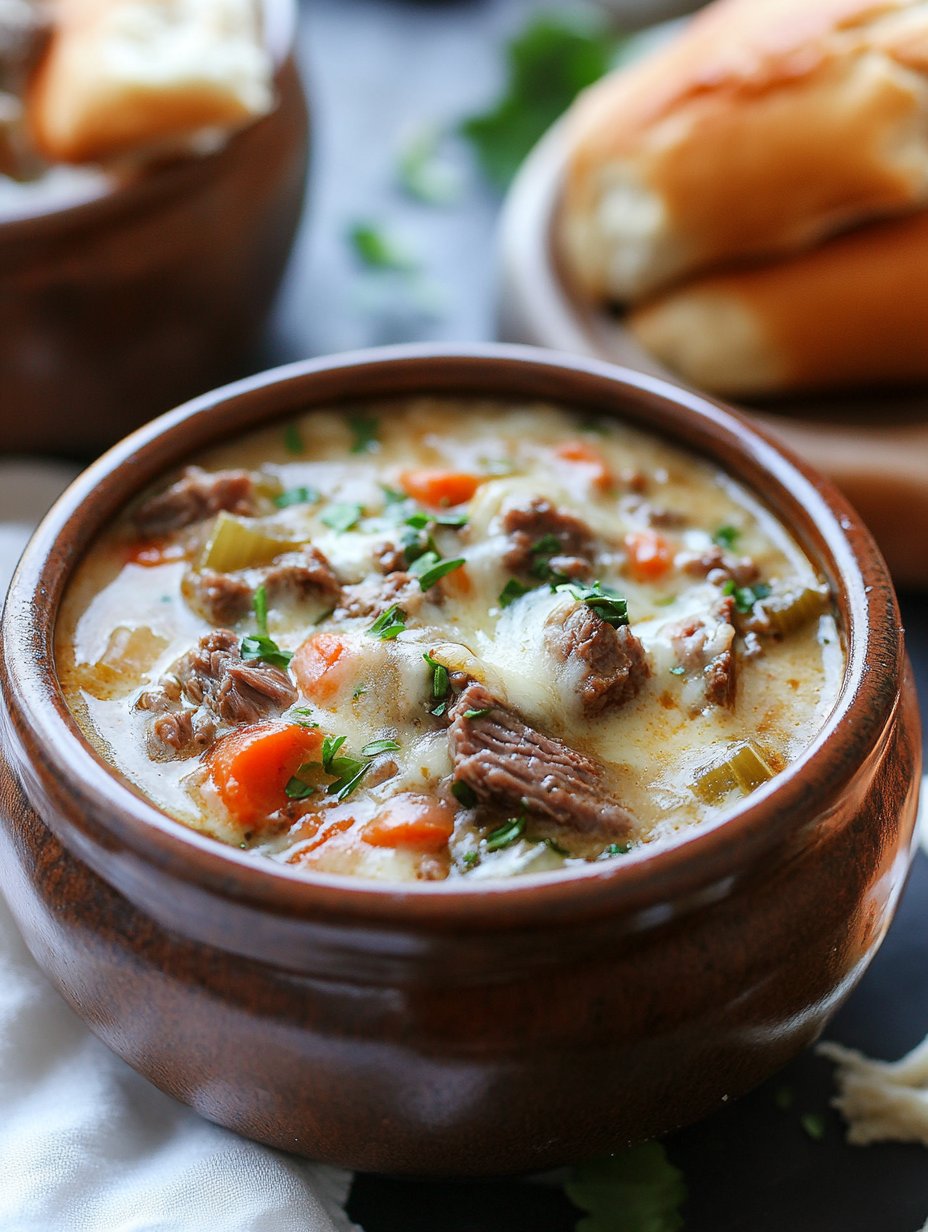The Philly Cheese Steak Soup Recipe: Comfort in a Bowl is not just a meal; it’s a delightful homage to the classic Philly cheesesteak sandwich that has been a beloved staple since the early 20th century.
Originating in Philadelphia, this iconic sandwich traditionally features thinly sliced beefsteak, melted cheese, and often onions, all nestled in a long hoagie roll. The flavors are so savory and satisfying that they have inspired various adaptations, including this rich and hearty soup version.
By transforming the sandwich into a comforting bowl of soup, you maintain the essence of the original while enjoying a new, cozy experience perfect for chilly days. This soup captures the spirit of Philadelphia's culinary culture and offers an innovative twist that's sure to impress.
For those looking to dive deeper into Philly's food history, check out Visit Philadelphia's guide. Whether you are a fan of the original sandwich or new to the concept, this Philly Cheese Steak Soup is a must-try for anyone who loves hearty, cheesy, and warming dishes.
Let's dive into this delicious recipe and explore its savory components.
Ingredients for Philly Cheese Steak Soup Recipe: Comfort in a Bowl
- 1 tablespoon olive oil
- 1 pound thinly sliced ribeye steak
- 1 large onion, diced
- 1 green bell pepper, diced
- 2 cloves garlic, minced
- 4 cups beef broth
- 2 cups heavy cream
- 8 ounces provolone cheese, shredded
- Salt and pepper to taste
- Crusty bread for serving
Instructions for Making Philly Cheese Steak Soup Recipe: Comfort in a Bowl
- Heat the olive oil in a large pot over medium-high heat.
- Add the thinly sliced ribeye steak and cook until browned. Remove from the pot and set aside.
- In the same pot, add the diced onion and green bell pepper. Sauté until the vegetables are tender.
- Stir in the minced garlic and cook for an additional minute until fragrant.
- Pour in the beef broth, scraping up any browned bits from the bottom of the pot.
- Return the cooked steak to the pot and bring to a simmer.
- Reduce the heat and stir in the heavy cream.
- Add the shredded provolone cheese, stirring until melted and fully incorporated.
- Season with salt and pepper to taste.
- Serve hot with crusty bread on the side.

Nutritional Information
This Philly Cheese Steak Soup offers a rich combination of flavors and nutrients, making it a hearty meal option. A typical serving provides approximately 400 calories, which includes a balance of protein, carbohydrates, and fats.
The ribeye steak is a good source of protein and iron, essential for muscle repair and oxygen transport in the body. The soup's heavy cream and provolone cheese contribute to its creamy texture and are excellent sources of calcium, supporting bone health.
The use of onions and green bell peppers not only adds flavor but also provides vitamin C, which is important for immune function. While this soup is indulgent, it can fit into a balanced diet when enjoyed in moderation. For more detailed nutritional information, you may visit NutritionData.
Always consider portion sizes and pair this soup with a fresh salad to add fiber and extra nutrients to your meal.
Wine/Beverage Pairings With Philly Cheese Steak Soup Recipe: Comfort in a Bowl
Pairing the right beverage with your Philly Cheese Steak Soup can enhance the dining experience. A full-bodied red wine, such as a Cabernet Sauvignon or Merlot, complements the rich flavors of the beef and cheese.
If you prefer a non-alcoholic option, consider a sparkling water with a splash of lemon to cleanse the palate between bites. A cold glass of iced tea, either plain or with a hint of peach or lemon, also pairs well with the savory notes of the soup.
For beer enthusiasts, a crisp lager or a pale ale can provide a refreshing contrast to the creamy texture of the soup. Choose a beverage that matches your personal preference to fully enjoy this comforting meal.

Cooking Tips and Variations
To elevate your Philly Cheese Steak Soup, consider these helpful tips and variations. If ribeye steak is not available, you can substitute it with flank steak or sirloin, which are also flavorful and tender when cooked properly.
For a spicier kick, add a pinch of red pepper flakes or a few dashes of hot sauce. If you prefer a thicker soup, incorporate a cornstarch slurry by mixing one tablespoon of cornstarch with two tablespoons of cold water, and stir it into the soup while simmering.
For a lighter version, replace the heavy cream with half-and-half or whole milk, though the soup will be less creamy. To make this dish gluten-free, ensure that the beef broth is certified gluten-free and serve the soup with gluten-free bread.
These variations offer flexibility and allow you to tailor the recipe to your taste or dietary needs.
Serving Suggestions
Serving Philly Cheese Steak Soup is all about creating a cozy and inviting atmosphere. Begin by ladling the hot soup into deep bowls, ensuring each serving contains a generous portion of steak, vegetables, and melted cheese.
Accompany the soup with slices of crusty bread, perfect for dipping and soaking up the rich broth. To add a touch of freshness and color, garnish the soup with chopped fresh parsley or chives.
If you wish to enhance the dining experience, serve the soup with a simple mixed greens salad dressed with a light vinaigrette. This adds a crisp contrast to the creamy soup, balancing the meal beautifully.
Additionally, consider serving this dish as part of a casual dinner party menu, pairing it with other comfort foods like roasted vegetables or baked potatoes. The versatility of this recipe makes it suitable for both family dinners and more sophisticated gatherings.

Philly Cheese Steak Soup Recipe: Comfort in a Bowl Health Benefits
While indulgent, the Philly Cheese Steak Soup does offer some health benefits when enjoyed mindfully. The steak provides high-quality protein, crucial for building and repairing tissues in the body. This nutrient-dense component also supplies essential amino acids, zinc, and B vitamins, which support energy metabolism and immune function.
The soup's inclusion of bell peppers and onions adds a dose of antioxidants and vitamin C, promoting overall health and aiding in the absorption of iron from the steak.
Though the heavy cream and cheese contribute to the soup's richness, they also provide calcium and phosphorus, important for maintaining bone health. For those watching their calorie intake, consider enjoying a smaller portion paired with a side of vegetables or a salad.
Moderation is key, and incorporating this soup into a balanced diet can allow you to benefit from its nutritional properties while savoring its delicious flavors.
FAQs About Philly Cheese Steak Soup Recipe: Comfort in a Bowl
Can I make this soup ahead of time?
Yes, this soup can be made ahead of time. Prepare the soup as directed and store it in an airtight container in the refrigerator for up to 3 days. Reheat it gently on the stove over low heat, stirring occasionally.
Can I freeze Philly Cheese Steak Soup?
It is not recommended to freeze this soup due to the cream and cheese content, which can separate when thawed and reheated, affecting the texture and flavor.
What can I use as a cheese substitute?
If provolone is not available, you can substitute it with mozzarella or a mild cheddar cheese, though the flavor profile will be slightly different.
The Philly Cheese Steak Soup Recipe: Comfort in a Bowl is a warm and satisfying dish that captures the essence of the classic Philly cheesesteak in a new form. With its hearty ingredients and creamy texture, this soup is perfect for cozy nights and gatherings with loved ones. Whether you enjoy it as a main course or part of a larger meal, its rich flavors are sure to please. Embrace the comfort of this delicious soup and indulge in a bowl that brings the taste of Philadelphia to your home.

